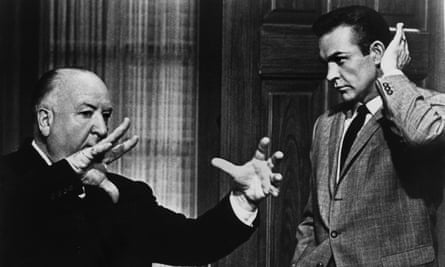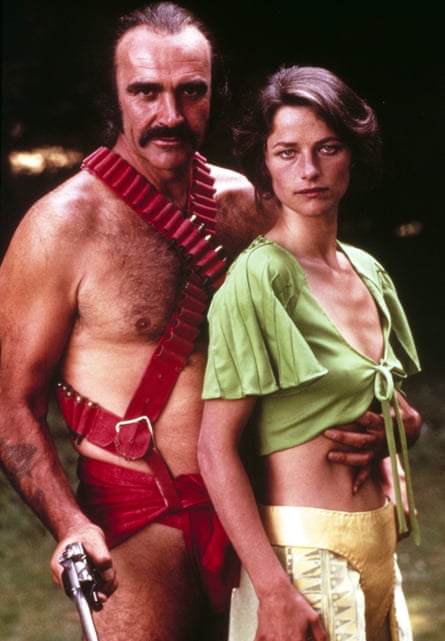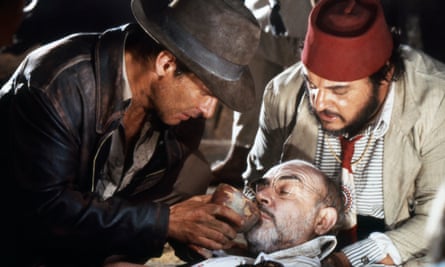 |
| Sean Connery as James Bond |
Sean Connery: a dangerously seductive icon of masculinity
Peter Bradshaw celebrates the career of the former milkman who brought a working-class edge to the role of James Bond before further unleashing a sense of menace in roles for Hitchcock and Lumet
Peter Bradshaw
Tue 25 August 2020
I
The introduction was a kind of challenge, or seduction, invariably addressed to an enemy. And the subtly anglicised Edinburgh accent, which appeared to soften or muddy those monosyllables, encouraged legions of comics and pub bores to think that they, too, could do the voice. In the early 60s, Connery’s James Bond was about as dangerous and sexy as it got on screen – until directors like Alfred Hitchcock and Sidney Lumet came along, and saw how Connery’s on-screen menace could be taken to the next level.
Connery became James Bond in 1962 after minor roles in British movies and an appearance in a Walt Disney whimsy called Darby O’Gill and the Little People. As 007, he was an instant, staggering success – conveying exactly the right dangerous sexiness and borderline-sociopathic capacity for disciplined violence – much mocked, much drooled over. The former milkman and bodybuilder was the working-class Bond, a Bond who had come up through the ranks, though director Terence Young reputedly schooled him in the ways of classiness: how to dress, how to light a cigarette. Connery’s natural muscular power and wry humour modified the elegance and eccentricity of Bond in just the right way. Ian Fleming was sufficiently impressed to fabricate Scottish roots for Bond in subsequent books.
 |
| Sean Connery and Ursula Andress in Doctor No |
As much as the Beatles, it was Connery’s charismatic Bond who kept alive Britain’s postwar amour-propre. Does Britain appear to be waning pathetically on the world stage? Oh no. Britain is still powerful – but in secret, you see, like 007. Connery’s Bond created the notion that the soft-culture brand image, the tricks and the toys, the gadgets and the cars, could be just as potent as real power and wealth. He played the role seven times, in Dr No (1962), From Russia With Love (1963), Goldfinger (1964), Thunderball (1965), You Only Live Twice (1967) and then two afterthought Bonds, Diamonds Are Forever (1971), when his hairline appeared suddenly to come forward after some years of retreat, and Never Say Never Again (1983), effectively a retread of Thunderball. His public image was merged with that of 007, and he accepted this burden with the same dangerously simmering resentment and controlled anger that made him such a glorious success as Bond. Perhaps only Daniel Radcliffe has experienced the same utter immersion or self-annihilation.
Connery went on to great things outside Her Majesty’s Secret Service – but it took a while. Long after he had handed in his gun and renounced his double-O licence, Connery maintained the prerogative of sexiness. For the 1999 heist caper Entrapment, nearing 70, Connery was considered an entirely plausible action lead and romantic partner for the 30-year-old Catherine Zeta-Jones.

His appearance in Hitchcock’s Marnie in 1964 focused on the dark side that had been nurtured in the Bond franchise, but without the justification of missions on the secret service, it looked more unsettling. His wealthy publisher Mark Rutland is arrogant, possessive – and a rapist. The saturnine darkness of Connery answers the strangeness and anxieties in Tippi Hedren’s mysterious Marnie.The other great Connery picture from the Bond years was Sidney Lumet’s brutal The Hill (1965), in which he plays a soldier sent to a military prison camp in the Libyan desert and forced, with the others, to endure sadistic punishments such as climbing a man-made “hill” in full pack in the burning sun. This role showcased the rougher, tougher side of the young Connery that 007 had smoothed away somewhat.

The 70s were a mixed bag for Connery. He appeared as the mysterious exterminator Zed in John Boorman’s cult sci-fi Zardoz (1974), and the famous image of Connery in a bizarre red posing pouch and thigh-length boots is something that has tested the faith of Connery fans for decades. He had another brilliant, brutal role in Sidney Lumet’s The Offence (1971) as a cop who has murdered a suspected child molester during interrogation and whose motivations are gradually disclosed in flashback.
He had two other great films in this period. John Huston’s The Man Who Would Be King (1975) was a classic epic in the Lean style, based on the Kipling novella, in which Connery and Michael Caine play British ex-military chancers Daniel Dravot and Peachey Carnehan. Trying their luck in the land of Kafiristan, they look to become staggeringly wealthy when the credulous natives mistake them for gods.
Richard Lester’s Robin and Marian (1976) found a quieter, gentler register in Connery, owning up to his advancing years, really for the first time in his career – playing the ageing Robin Hood, opposite Audrey Hepburn’s Marian.
The 80s saw Sean Connery in various autumnal and humorously self-deprecating moods. His simmer and smoulder had aged well into a potent maturity – Connery endured endless “single malt” analogies from well-meaning interviewers – and that baldness, once feared, looked like authentic masculinity. He played Agamemnon in Terry Gilliam’s Time Bandits (1981), and he also won a much-merited Academy Award for best supporting actor in Brian De Palma’s The Untouchables (1987), playing the courageous, straight-arrow cop Jimmy Malone, who helps Kevin Costner’s Eliot Ness take on Al Capone, played by Robert De Niro.
Connery’s comic chops were on display playing Professor Henry Jones, disapproving dad of Indiana Jones, in Indiana Jones and the Last Crusade (1989) – though Connery was only 12 years older than Ford. There were other roles, and Connery contributed to Finding Forrester (2000) and The League of Extraordinary Gentlemen (2003) with great aplomb. By this time, his legendary status, quite distinct from Bond, was something he carried around with him.

I’ve met Sean Connery just once, in 1999, at the Edinburgh film festival, of which he was patron, introduced to him by the festival’s then artistic director Lizzie Francke. Unlike other men of his age, Connery seemed to have got taller with his years, and I remember almost leaning back to look up at him, as if trying to see the flagstaff atop a famous building – although that was maybe just natural awe. He stood as still as a statue at those public red-carpet events, and let the guests and the paparazzi come to him.
I remember him saying to me, crisply, and with a formidable air of daring me to disagree: “Lynne Ramsay’s Ratcatcher is a great film.” It was the opening film at Edinburgh that year. Of course I agreed, but could think of nothing worthwhile to do or say other than to open and close my mouth idiotically, like a goldfish, and finally squeak “Yes.” After a second or two, Sir Sean turned and resumed his conversation with Lizzie, accustomed to this sort of encounter with gobsmacked male journalists. But I’m glad I said something to this legendary figure – and didn’t try to introduce myself formally.
FICCIONES
Casa de citas / Sean Connery / Tal vez no sea un buen actor
DE OTROS MUNDOS
Dr No / El inicio de la saga de James Bond
Muere el actor Sean Connery a los noventa años
Sean Connery / James Bond
PESSOA
Morre o ator Sean Connery, aos 90 anos
DRAGON
Sean Connery / A Dangerously seductive icon of masculinity
Obituaries / Sean Connery
RIMBAUD



No comments:
Post a Comment